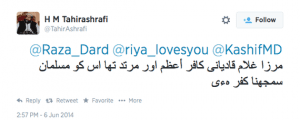Originally published in The Huffington Post
Pakistan’s supreme organization of religious clergy, the Pakistan Ulema Council (PUC), recently held a national conference titled, “Why dialogue between various sects and religions is essential.” The Council’s central Chairman, Mr. Tahir Mahmood Ashrafi, presided over this well-attended conference in Islamabad, Pakistan.
The conference was widely reported by the media. And why wouldn’t it? Pakistan’s authoritative clerical office finally appeared to make sense. Six decades too late, the clerics finally agreed to condemn sectarian violence and promote interfaith harmony — or so it seemed.
Pakistan’s history is soaked in the blood of those who have — and continue to — suffer agonizing pains on the basis of their faith. Right in the start, a newborn Pakistan was gripped by sectarian violence when extremist clerics belonging to theJamaat-e-Islami and Ahrar groups led nation-wide riots against the moderateAhmadiyya Muslim community. In 1954, the head of the Jamaat-e-Islami, Maulana Maududi, was handed the death penalty for his role in initiating this unrest. Later pardoned, he — and clerics from other religious parties — continued to espouse bigotry, spread hatred and incite violence against the Ahmadi Muslims. These clerics considered the Islamic sect Kaafir or heretic and often declared its adherents Wajib ul Qatal or worthy of death. In 1974, the clerics succeeded in inscribing this sectarian bigotry into the Constitution of the State. The Ahmadi Muslims were declared non-Muslim by State. In 1984, the military dictator, General Zia, outlawed free profession of religion for the Ahmadi Muslims altogether. Many prominent right-wing clerics were still not happy. They demanded death for all Ahmadis. Pakistan’s Ahmadiyya Muslim Community — victim to one of the most heinous examples of religious fanaticism in modern history — was reduced to a bitterly marginalized Ahmadiyya Community.
As anticipated, the anti-Ahmadi hysteria spilled over and the Shia Muslims found themselves next in line. Today, Pakistan is one of the worst nightmares for an adherent of any minority sect, let alone a different religion. There is no doubt, therefore, that the country is in bad need of interfaith harmony and dialogue to reverse the wrongs of our bigoted religious clergy.
The PUC’s recent conference was intended to be such a dialogue. Some looked on with hope. However, the fact that no Ahmadi Muslim was invited to represent the five million Pakistanis who have suffered the most — and continue to — at the hands of religious bigotry, put the very aim of the conference in jeopardy. Imagine a women’s rights convention without women? Or an anti-racism rally that forbids blacks from attending?
Nevertheless, I followed the proceedings with an open mind. The high clerical office issued a seven-point sectarian “code of conduct” at the end of the conference. In this code, attitudes that lead to sectarian violence were identified and condemned:
1. The council condemned Takfeer (declaration of heresy) and warned that no Islamic sect should be declared heretic because God was the ultimate judge of man’s faith. Pakistan’s own constitution declared the Ahmadiyya Muslim sect heretic in 1974. Were the country’s highest clerics suggesting an amendment to the constitution? Curious, I put this question to the chairman of the Council, Mr. Tahir Ashrafi, to which he responded back saying: “Qadianis (pejorative for Ahmadis) are heretics and outside the pale of Islam.”
4. The Council also concluded that discriminating against a Pakistani on the basis of their religious beliefs was a violation of the Constitution and of Islam that required legal action. Ironically, this Council endorses such religious discrimination and persecution signed into Pakistan’s Constitution and legal code. The council not only endorses the existing legal restrictions that jail Ahmadis for ‘posing as Muslim,’ and the consequent apartheid of Ahmadis in Pakistan, but suggests stricter rulings and further banishment of the community.
5. The council asserted that publication and distribution of offensive and hateful books, literature, websites etc should be banned. Did Pakistan’s clerics just condemn the mammoth hate propaganda against its Ahmadi Muslims (examplehere) and call for its containment, I wondered? The Chairman of the council confirmed from his tweets that I was merely fantasizing.
This conference by Pakistan’s highest clerical office has highlighted the fact that the clerics have the ability to identify the causes of religious violence — it is the will to apply that is entirely lacking. Until the Council invites and extends its “code” to include Pakistan’s most victimized religious community — the Ahmadi Muslims — any move to usher in sectarian harmony will be counter-intuitive and be seen by the world as hypocritical. If Pakistan’s Ulema Council is serious at all in condemning religious violence and fanaticism in Pakistan, it should apply its seven-point code on itself, starting from its Chairman.


